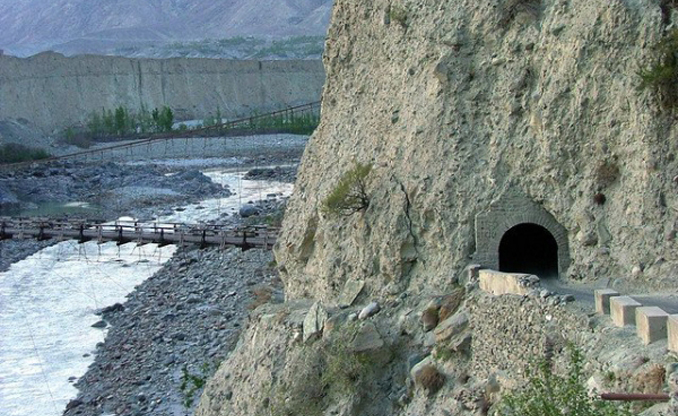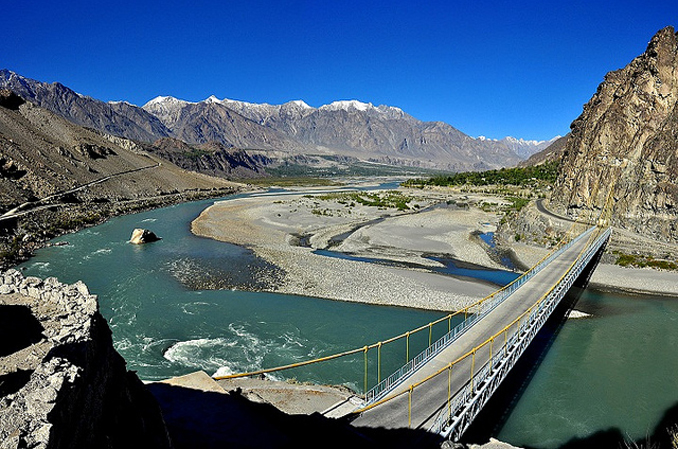Written by: Omer Qayyum and Amna Javed
Posted on: February 19, 2015 | 
Gilgit Valley
With its picturesque landscapes and central location, this area is at the heart of all mountaineering expeditions from the Karakoram to the Himalayas. Giglit, with its unique cultural heritage and rich biological diversity, has a charm of its own. The jovial residents, heavenly landscapes and beguiling waterfalls make this city a sizzling tourist destination. The construction of Gilgit Airport has made access to the city easier and more convenient, resulting in a considerable increase in the number of tourists.
 |
Danyore Bridge |
The city is famous for being surrounded by the highest mountains of the country, including Nanga Parbat and K-2. A remarkable contrast is visible with snow-covered mountaintops in the backdrop and green fields at the forefront. Gilgit Bridge, the largest suspension bridge in Asia, is an attraction for all adventurists. Passing over the Gilgit River, it has adequate room to allow one jeep to cross at a time. Besides this, there are tourist attractions such as the Chinar Garden, the City Park and the Chinese graveyard in Danyore, a neighboring village of Gilgit city. This graveyard is shaded by tall evergreens, and houses traditional graves of Chinese workers who died during the construction of Karakoram Highway. At a distance of approximately 10 kilometers from Gilgit City, in the valley of Kargah, rock carvings have also been discovered. These were imprinted in the seventh Century and unearthed in 1939. The local legend holds that these carvings speak of a myth relating to the giant named Yakhsni, who was beaten by a resident of Kargah. The historical perspective attached to this area draws history enthusiasts to visit this valley.
Gilgit is also considered the center of education for the Gilgit-Baltistan region. Locals and the administration, both laud the services of Agha Khan in the field of education. The government, in collaboration with Agha Khan Education Service, has successfully established numerous schools and colleges to provide local children with access to quality education. Recently, the Karakoram International University, the only university in Giglit-Baltistan, has also been established in the city. Moreover, the programs and projects undertaken by Agha Khan Development Network in other areas of Gilgit-Baltistan also continue in Gilgit city.
 |
Similar to Hunza, Gilgit also has the tradition of fitting decorative lights on mountains to commemorate important religious festivals such as Eid Milaad. These lights are shaped in a manner that reads out messages such as the Holy Prophet (PBUH)’s name, or the words Ya Ali on Hazrat Ali’s birth anniversary.
Gilgit is also a great place for shopping. The attractive mountainous city is famous for its crockery, silk, woolen cloth, shawls, handicrafts and jewellery. Shawls woven from Markhor wool, called shahtosh, are a rare and sought-after commodity.
Naltar Valley, situated close to Gilgit city, is another popular tourist destination. The valley is a forty-minute jeep ride from Gilgit and has been preserved in its natural form. Naltar is a pine village known for its flowers, wildlife, trekking routes and mighty mountains. Tourists can also enjoy trout fishing in small lakes that flow through the valley. Efforts are underway to transform Naltar into a world-class skiing resort, equipped with modern logistical facilities and important necessities. Recently, a 180-seater ski-chairlift has been installed in the valley with the help of Swiss and Chinese experts. The installation of chairlifts and the development of Naltar as a ski resort is an endeavor of the Ski Federation of Pakistan, and much of the ongoing development has been spearheaded by the incumbent Air Chief Marshal Tahir Rafique Butt, during his tenure as President of the Ski Federation of Pakistan. The valley boasts tremendous potential to develop skiing and other winter sports. Moreover, summer sports such as grass skiing and roller-skating can also be introduced.
 |
View of sunrise from Upper Shani Camp, Naltar Pass |
However, the road leading to Naltar from Gilgit needs to be improved in order to reduce travel time and make the journey less exhausting. While developing the area for these sporting events, it must be ensured that the natural beauty of the valley is preserved and necessary precautions are taken to avoid any environmental damage.
The area is prone to climatic changes such as global warming and glacier diminution, which can result in flooding. This could disturb agricultural activities, drinking water supply, hydroelectric supply and ecological habitats in the country. Considering these risks, there is an urgent need to address the threat of global warming, and to maintain the natural beauty of these areas.
You may also like: